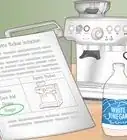This article was co-authored by wikiHow Staff. Our trained team of editors and researchers validate articles for accuracy and comprehensiveness. wikiHow's Content Management Team carefully monitors the work from our editorial staff to ensure that each article is backed by trusted research and meets our high quality standards.
The wikiHow Culinary Team also followed the article's instructions and verified that they work.
This article has been viewed 384,342 times.
Learn more...
If you're craving an espresso or espresso based drink, you can make one at home using a French press, by brewing espresso grounds to get a similar taste and consistency. This method for espresso involves grounding your beans correctly and using your French press to get the desired taste and texture. And if you want more than just espresso, you can add foam or whipped cream for more flavor.
Steps
Preparing Your Beverage
-
1Assemble your ingredients and tools:
- French press
- Freshly ground coffee beans ground to espresso setting.
- Measuring spoon
- Stirring stick
- Hot water
-
2Lift the lid/filter assembly out of the pot. This is the top of your French press that is comprised of the lid and a rod that screws into the mesh filter.
- The mesh filter and the plunger is what you will press down on the coffee grounds and water. The filter separates the grounds from your beverage for drinking. Make sure it is pulled up when you remove it.
Advertisement -
3Heat your water. Using a stovetop safe kettle, heat your water.
- As your kettle begins to heat the water, warm the glass container of your French press by swirling some hot water in it. Adding a bit of warm water ensures the glass won’t crack from the sudden temperature change when you add boiling water later.
-
4Grind your beans. The grind of your beans is going to be a large factor in how close you get to having a drink that resembles an espresso. If you are buying ground beans, then look for an espresso grind.
- If you are grinding your own beans, still look for coffee that says "espresso beans" or "espresso". While there is no actual espresso type of bean, often commercial roasters will have an espresso bean. This will give you a taste and consistency to which you are used to because it is roasted to bring out the espresso flavor.
- If you grind your own beans, you will want a grinder that can offer you an espresso grind. Burr grinders are grinders which actually grind the beans between two burrs. These grinders crunch up a few beans at a time and grind the bean into a nice even powder.
- Blade grinders can be effective as well. However, with a blade grinder, you’re using a sharp propeller to chop the beans. This method can be less consistent. [1]
- The espresso ground is very fine. It is finer than what you would have if you were grinding beans for a regular French press or a drip coffee maker. The fine ground contributes to the flavor and ability to mix with the hot pressure of water. You don’t want an espresso grind to be so fine that it goes through your filter. The problem with this fine of a grind in a French press is that the filter has a larger mesh. It should be like sand. [2]
- You may then want to make your grind slightly more coarse, but not much. Unless you don’t mind a bit of grounds in the bottom of your cup.
-
5Add your grounds to your press. Pour roughly 36 grams (1.3 oz) of grounds into your press.
- This part is a bit tricky because you are trying to make espresso. Which when prepared in an espresso machine uses about 16-21 grams of grounds per 1 cup of water. Since your French press is larger, try doubling your proportions. You’ll have some espresso left over but that’s ok.
-
6Pour a splash of near boiling water over the grounds. Then after a few seconds add the remainder of your two cups of water.
- Your water should not exceed 200° F, around 195° F is ideal.
- Before pouring in your full two cups of water, just add a splash to let the grounds flour and bloom. This will open the grounds up and let the flavors really come out.
-
7Stir your brew. Give the brew a quick stir with a long-handled spoon to prevent clumps and add a nice frothy consistency. Then push the lid/filter assembly down until it just rests on the water.
- Don’t plunge your filter down yet. You need to let the coffee steep.
-
8Steep your brew. Let it steep until the coffee is very dark (about 3-4 minutes).
- The longer you steep, the stronger your coffee will be. However, this does not mean that you should steep your espresso too long just to get a stronger, more espresso-like flavor.
- Steeping is another area for experimentation. Just be aware of one rule: The length of steep time controls extraction. Too short and the coffee will be under-extracted and sour; too long and the coffee will be over-extracted and bitter.
-
9Press your brew. Hold the lid to steady and press the plunger down slowly in a steady, even manner until it stops.
- You may want to experiment with plunging halfway, bringing it up, and then plunging it down all the way to create a thin layer of foam.
-
10Let your brew set briefly before pouring. Pour your coffee through a clean cloth or a coffee filter if you want to catch any of the very fine sediment.
- Note that pouring through a paper filter will alter the consistency and flavor of your drink slightly. The paper will catch some of the texture of your drink, and possibly transfer an oily essence as your coffee steeps through.
Frothing Hot Milk/Cream for Espresso
-
1Heat the milk. Pour at least 1/2 cup of milk in a medium saucepan and heat on low or medium.
- Heat the milk until it is warmed through. You don’t want your milk to boil. Heat just until it starts to bubble then turn the stove off.
- The thicker the milk or cream you use, the thicker your foam will be. However, using 2% or low-fat milk may be easier if you are frothing by hand. Lower-fat milks usually include whey proteins that are critical stabilizers for milk foam.
-
2Prepare your espresso in your French Press. While the milk is being heated, make your espresso using the first method.
- You can also heat the milk while the beverage is steeping.
-
3Remove the milk from heat. Do this while the coffee is steeping.
- Place the pan on a towel or surface that isn’t hot but that won’t get damaged by the heat from the pan.
-
4Blend the milk. Angle your pot and set an immersion blender in the shallow end of the pot. Froth the milk on high speed until the foam holds, about 2 to 3 minutes blending on high.
- If you don’t have an immersion blender, you can use a whisk and stir the milk in a smaller container. Stir by rotating the whisk back and forth between the palms of your hands. Stir until your milk is bubbly and frothy.
-
5Pour the frothy milk into a jar with a lid. Once you’ve poured your milk, tighten the lid and give the jar a good shake. [3]
- Don’t fill the jar more than halfway. This won’t leave enough room for the milk to foam.
- Shake until the milk is bubbly and nice and foamy. You should be shaking for about 30 to 60 seconds.
- Then microwave the jar (making sure you have a microwave safe jar) for about 30 seconds. This allows the foam to rise to the top.
-
6Pour your espresso coffee. Divide the coffee out amongst the cups and spoon the frothed milk on top of each. Serve immediately.
- You can also pour the leftover milk into your drink if you like milk in your drink.
Frothing Cold Milk/Cream for Espresso
-
1Chill about 1/2 cup of milk in a small glass or stainless steel bowl. Place the bowl in the freezer for 15 to 30 minutes, or until the temperature reaches just above freezing.
- The thicker the milk or cream you use, the thicker your foam will be. However, using 2% or low-fat milk may be easier if you are frothing by hand. Lower-fat milks usually include whey proteins that are critical stabilizers for milk foam.
- Check on your bowl to make sure the milk hasn’t frozen. There should not be any ice crystals.
-
2Prepare your espresso in your French Press. While the milk is being cooled, make your espresso using the first method.
- You can then make the foam while your coffee is steeping.
-
3Remove the bowl from the freezer. Once you remove the cold milk from your freezer set it on a towel on your counter top.
- You can now go about frothing your milk in a couple of ways. One way is to proceed as you would with milk heated on the stove. Blend the milk, then shake and microwave. Another way is to blend and shake. But not microwave.
-
4Tip the bowl and insert your immersion blender. You can also pour your milk into a smaller container for easier blending or whisking. Blend until there is a good, stiff froth.
- If you don’t have an immersion blender, you can use a whisk and stir the milk in a smaller container. Stir by rotating the whisk back and forth between the palms of your hands. Stir until your milk is bubbly and frothy.
-
5Pour the frothy milk into a jar with a lid. Once you’ve poured your milk, tighten the lid and give the jar a good shake. [4]
- Don’t fill the jar more than halfway. This won’t leave enough room for the milk to foam.
- Shake until the milk is bubbly and nice and foamy. You should be shaking for about 30 to 60 seconds. You can leave the cold froth as is, or microwave if you want extra foam.
- Leaving the froth cold will mean that you have to scoop it right away onto your drink before it settles back in.
-
6Spoon out the froth onto your coffee and enjoy. Take a spoon and place a dollop of froth onto the top of your drink.
- Sprinkle with cinnamon for added flavor.
- You can also pour the milk mixture into your drink if you like.
Making Whipped Cream For Espresso
-
1Prepare your ingredients for whipped cream. For those who would like to use whipped cream, this is a basic recipe:
- 1/2 pint heavy cream, chilled
- 1/2 teaspoon vanilla extract
- 1 tablespoons powdered sugar
-
2Whip the cream. Using a stick blender or whisk, whip the cream in a large bowl until soft peaks form.
- It sometimes help to whip the cream and get a fluffier consistency if you use a metal bowl and whisk. Place the cream in the bowl with the whisk and let it sit in the freezer for 10 to 15 minutes.
- You may also want to add some sugar before you start whisking. the sugar will help the cream to clump and form.
-
3Add the vanilla and the sugar. Continue to beat the mixture until it reaches the consistency of whipped cream.
- You can place your bowl back in the fridge to cool if you are still brewing your beverage.
-
4Prepare your espresso in your French Press. While the cream is cooling in the bowl, make your espresso using the first method.
- You can then finish making your whipped cream while your beverage steeps, if you haven't yet. Make sure that you've whipped your mixture so it's fluffy and not runny.
-
5Add a dollop of whip cream to your beverage. Once you have your desired consistency, add a dollop to your beverage.
- You can also stir the whipped cream into your beverage if you want more of a Frappuccino® drink.
-
6Finished.
Community Q&A
-
QuestionOk, so for the froth, could I use soy milk/almond milk?
 Community AnswerYes, you can steam or foam plant-based milks for drinks. However, they may not "froth up" as much as regular milk. All the same, they'll still be delicious!
Community AnswerYes, you can steam or foam plant-based milks for drinks. However, they may not "froth up" as much as regular milk. All the same, they'll still be delicious!
Recipes
Select a recipe from one of the many below. Why not try them all?
Frapputini
- 8 ounces good, strong coffee
- 1 1/2 ounce heavy cream/frothed cream
- Flavoring or extract as desired, to taste
- Sugar to taste
- 1/4 teaspoon pectin to thicken. Adjust as desired.
Irish Coffee
- 3 shots espresso or 8 oz. of good strong coffee
- 1 oz. heavy cream/frothed cream
- 1/4 teaspoon mint extract (adjust to taste)
- Whipped cream (Optional)
- 1 shot Irish Whiskey (Optional, for the American bar drink.)
Cappuccino
- 4 ounces of your favorite, good quality, coffee
- 4 ounces whole milk, frothed
- Pour 4 ounces coffee into your cup.
- Add 4 ounces hot whole milk.
Macchiato
- 4 shots espresso (or 1 1/3 cups regular coffee)
- 1 cup heavy cream
- Pour shots of espresso into mugs.
- Add 1/4 cup of the heavy cream.
- Top each mug with a dollop of whipped cream.
Latte
- 2 (1 1/4-ounce) shots espresso, hot
- 12 ounces milk, steamed to 150 degrees
- 1 tablespoon frothed milk
- Pour both espresso shots into the bottom of a cup.
- Add steamed milk until the cup is 3/4 full, holding back the foam.
- Top off the drink with velvet foam from frothed milk.
Things You'll Need
- Café press pot, AKA Cafetiere or French press. These can be found in most department stores, kitchen departments, or coffee shops.
- Immersion blender, sometimes called a stick blender. These can be found in most department stores.
- Fresh, quality coffee
- Milk or heavy cream
- Saucepan
References
- ↑ http://www.thekitchn.com/coffee-tools-what-kind-of-grinder-should-i-use-204496
- ↑ http://ineedcoffee.com/coffee-grind-chart/
- ↑ http://www.thekitchn.com/how-to-froth-milk-for-cappuccinos-in-the-microwave-cooking-lessons-from-the-kitchn-100716
- ↑ http://www.thekitchn.com/how-to-froth-milk-for-cappuccinos-in-the-microwave-cooking-lessons-from-the-kitchn-100716
About This Article
To make espresso beverages with a French press, start by boiling 2 cups of water in a kettle. Then, while that's boiling, add 1.3 ounces of ground espresso beans to your French press. Once the water boils, pour it over the grounds and give the brew a stir to remove any lumps. Next, brew the coffee for 3-5 minutes, and heat milk in a pan before whisking it until it's frothy. Then, shake the milk in a jar until it's bubbly. Finish by pouring your coffee and adding the milk on top. For tips on how to make whipped cream for espresso and how to froth cold milk, keep reading!
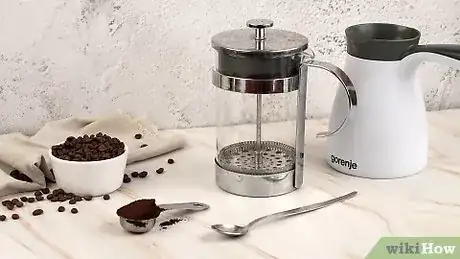


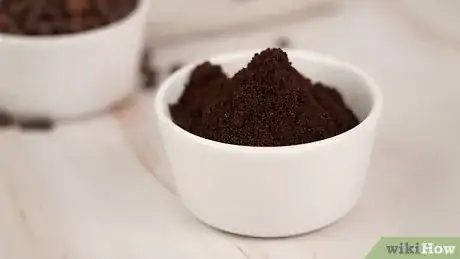
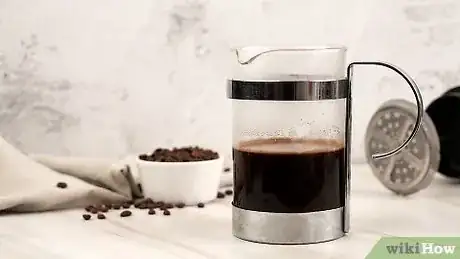



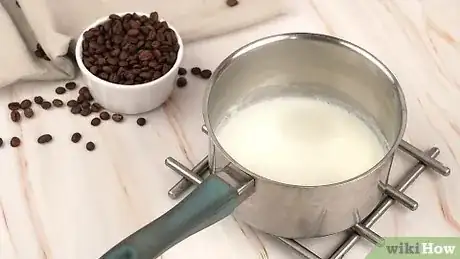

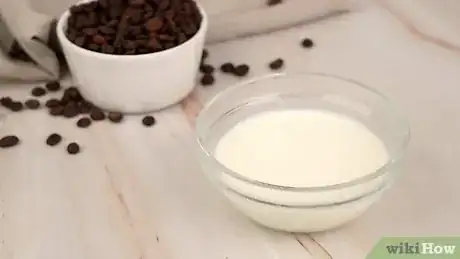
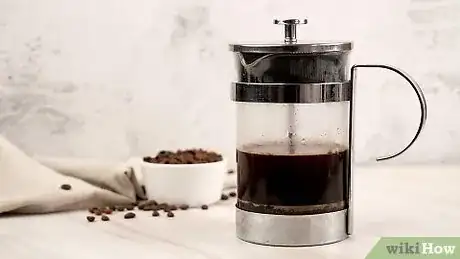


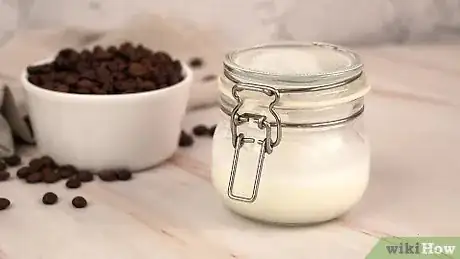

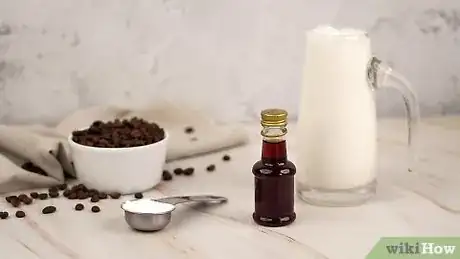

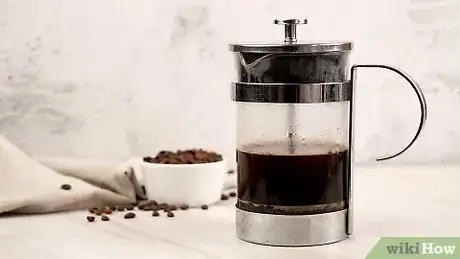
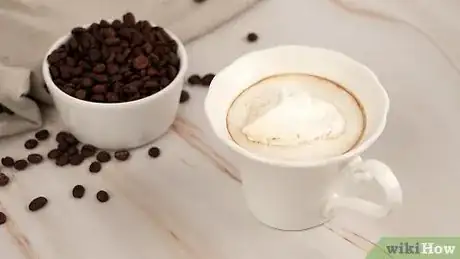
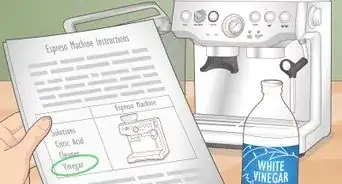
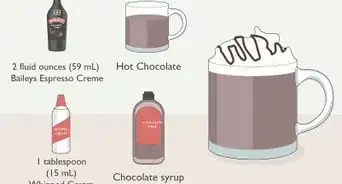
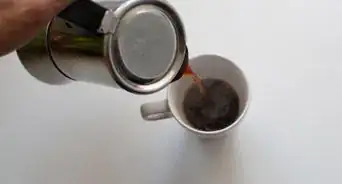










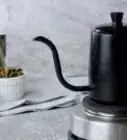
-Step-13.webp)

